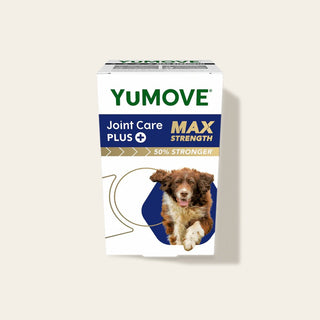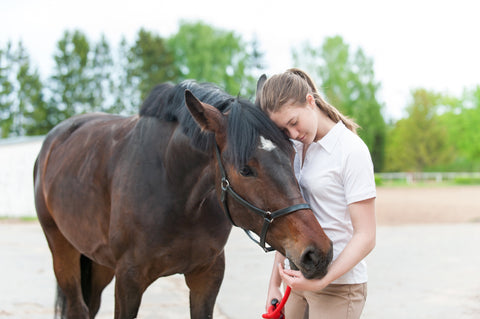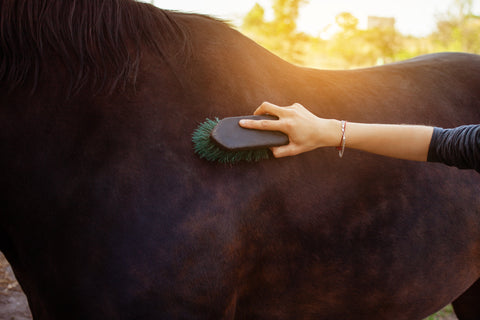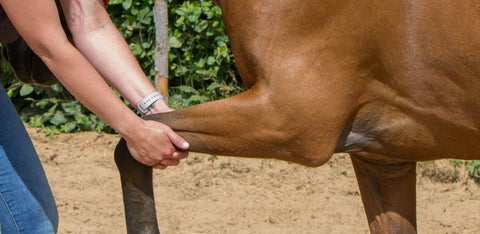
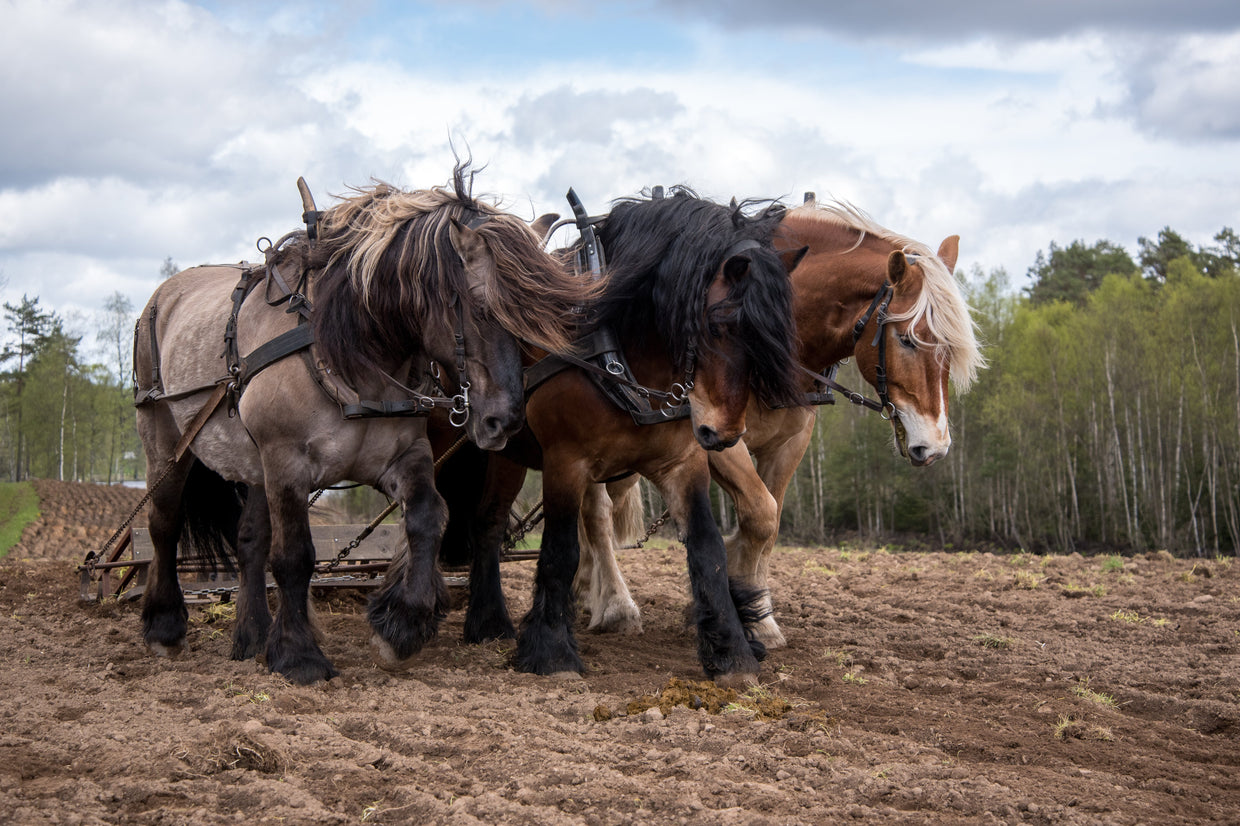
All about working horses
A brief history of service horses
Since they were domesticated over 5,000 years ago, the link between horses and humans has been strong. From cave paintings to the ranches of the Wild West in the US, horses have made an appearance throughout the whole of human history. Over the years, they’ve been an ally to us, through their contribution to hunting, transport, warfare and agriculture.
In fact, horses actually influenced the development of humans as a species. Without horses, we would still be travelling by foot (as they were a precursor to locomotives and cars), and many civilisations wouldn’t have risen or fallen without the helping hoof of the lowly horse.
What breeds are used as working horses?
Typically, working horses are big and strong breeds, such as the Shire. This is because they’re often used to pull and carry loads. It’s also essential that the individual horse is calm and easy to work with. Having said that, horses (and ponies) of all sizes have been called upon over the years.
The horses in the Metropolitan Police are usually either half thoroughbred and half draft breed, or three-quarters thoroughbred and one-quarter draft breed. Many breeds have been used throughout the history of warfare – such as the Arabian and Akhal-Teke, as well as stronger horses like the Percheron and Friesian. In World War I, the British forces used mainly Clydesdale horses.
Horses and warfare

Horses were last used in a combat role by the British Army in World War I. During this time, a million horses were sent to the frontline in battle. In World War II, the role of horses changed slightly. Instead, they were used only as mules to carry supplies to ally troops.
What kind of horses were used in World War I?
Before the war, Britain was a nation of horses. From 1811 to 1901, the number of horses tripled to 3 million, 10% of the human population at the time. Compared to today’s figure, where horses only accumulate to a tiny 1% of the human population.
Many different types of horses were used in this time, but particularly draft horses, hard-working farm horses and racing Thoroughbreds. As the war broke out, the Army imported horses from the US, Canada and Australia. And they also enlisted thousands of civilian horses to serve alongside their soldiers.
The modern cavalry

You might be surprised to know that the Army currently has 485 horses – twice as many horses as tanks!
Today, horses exist in a purely ceremonial role within the British Army. There are two regiments in the modern-day Army that involve horses. The first is The Household Cavalry which consists of Lifeguards and The Blues and Royals. The other is the Royal Horse Artillery. Not only this, but horses and troopers (the people who take charge of the animals), are paraded for many Royal events, such as weddings, Jubilees and Remembrance Sunday.
Mounted horses

You probably already know that horses are used in London’s Metropolitan Police Force. But did you know they even have their own division? The Metropolitan Police Mounted Branch was founded in 1760. This branch of police horses is used to patrol London (specifically the main parks), for ceremonial events and for crowd control after football matches and during riots.
This branch has eight stables across London: Hyde Park, Lewisham Police Station, Great Scotland Yard, Hammersmith, West Hampstead, Bow Road, Kings Cross and Imber Court in East Molesey, Surrey, where the horses are trained.
Every day, the officers will be allocated a horse and a specific duty. Before heading out, the horses will be groomed, fed and their tack prepared (such as saddle, reins and patrol bridles). During a general patrol, the horse will be on a three-hour shift before being driven back to their stable in their trailer.
Guide horses
The UK’s first guide horse
Digby, a two-year-old American miniature, became the UK’s first guide horse in 2019. As part of his training programme, he visited restaurants, pubs, shops and even rode a train to become acclimatised to everyday life.
It’s been proven that guide horses can do everything guide dogs can do. And they have the added advantage that they live much longer. They can live up to 40-years-old, whereas the average guide dog is retired at 10 or 11.
Guide horses in the US
Across the pond, miniature horses have been officially recognised as service animals. The process of training a mare to be a guide horse takes around eight months. During this time, they’re trained to listen to basic commands, to signal when there’s a step or ramp, and are housebroken.
A vital aspect of a guide animal is eyesight. Luckily, horses generally have excellent eye sight, thanks to monocular vision and a 340-degree view.
Working horses

Horses are still used for transport and agricultural work today. On farms, horses are used for everything from pulling carts and ploughing to land preparation. These horses tend to have bigger builds and broad backs, ideal for carrying loads, and powerful hind quarters.
How to look after a working horse
Grazing and shelter
Horses need a great deal of land to graze, as well as extra room for pasture rotation. Plus, their fencing shouldn’t contain sheep netting or barbed wire, as both can result in injuries. As you can imagine, horses are very strong and can cause damage to fences. Try opting for post and rail fencing as this is one of the sturdiest kinds.
Most working horses are resilient and can therefore be turned out all year round. But you should always provide a shelter to protect them from harsher weather, like wind, rain and snow. The shelter also doubles up as a space where your horse can be confined if necessary.
Feeding
Horses need a lot of grazing. Most people think that forage simply exists to increase your horse’s calorie consumption. But if combined with a balanced diet, hay and haylage boosts your horse’s nutritional intake. That’s because high-quality forage provides plenty of protein.
Coat care
A grooming regime is one of the most important things for a horse. Not only does it enhance the look and shine of their coat, but it also provides lots of other benefits. It gives you an opportunity to check your horse over for cuts, scratches, infections and ticks. And it also reduces the risk of skin problems like thrush.
Joint health
One of the biggest parts of your horse’s overall wellbeing is their joint health. The work a horse does can sometimes be hard on their joints and muscles. That’s why it’s so important to take proper care of their joint structure. YuMOVE Horse has been specifically developed to support joints in horses of all ages. It’s packed with the finest quality active ingredients to soothe stiffness, promote mobility and support long-term joint health.
What’s in YuMOVE Horse?
- Glucosamine HCl
- Vitamins C and E
- Hyaluronic Acid
- Green Lipped Mussel
- MSM
All these powerful ingredients work in tandem to aid mobility and soothe joint stiffness. The best part? We use a unique form of Green Lipped Mussel and Hyaluronic Acid not used in any other pet supplements.
Want to learn some weird things about horses? Delve into 10 fun and interesting facts about horses.
